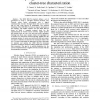Free Online Productivity Tools
i2Speak
i2Symbol
i2OCR
iTex2Img
iWeb2Print
iWeb2Shot
i2Type
iPdf2Split
iPdf2Merge
i2Bopomofo
i2Arabic
i2Style
i2Image
i2PDF
iLatex2Rtf
Sci2ools
PERCOM
2008
ACM
2008
ACM
Topology Formation in IEEE 802.15.4: Cluster-Tree Characterization
The IEEE 802.15.4 standard defines a set of procedures to set-up a Low-Rate Wireless Personal Area Network where nodes self-organize into a logical communication structure through which data can be routed, hop by hop, from sources to destinations. The network formation of the IEEE 802.15.4 does not impose constraints on the topology. The ZigBee Alliance uses the IEEE 802.15.4 layers to build a complete protocol stack for the implementation of wireless sensor networks. ZigBee specifies the network layer for star, tree and peer-to-peer topologies. Starting from these, more complex cluster-tree topologies can be formed. To control the network topology ZigBee fixes the maximum number of routers and end-devices that each router may have as children and also fixes the maximum depth of the tree. To better understand the importance of these constraints we simulate and analyze the IEEE 802.15.4 formation procedure in different network settings (single-sink and multisink scenarios). The goal is ...
IEEE 802.15.4 Formation | IEEE 802.15.4 Layers | Network Formation | PERCOM 2008 | Wireless Networks |
| Added | 24 Dec 2009 |
| Updated | 24 Dec 2009 |
| Type | Conference |
| Year | 2008 |
| Where | PERCOM |
| Authors | Francesca Cuomo, Sara Della Luna, Petia Todorova, Tapio Suihko |
Comments (0)

